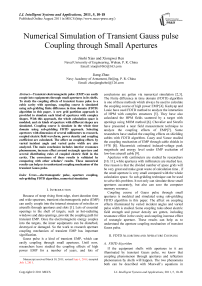Numerical Simulation of Transient Gauss pulse Coupling through Small Apertures
Автор: Jinshi Xiao, Xiongwei Ren, Jiang Zhao
Журнал: International Journal of Intelligent Systems and Applications(IJISA) @ijisa
Статья в выпуске: 5 vol.3, 2011 года.
Бесплатный доступ
Transient electromagnetic pulse (EMP) can easily couple into equipments through small apertures in its shells. To study the coupling effects of transient Gauss pulse to a cubic cavity with openings, coupling course is simulated using sub-gridding finite difference in time domain (FDTD) algorithm in this paper. A new grid partition approach is provided to simulate each kind of apertures with complex shapes. With this approach, the whole calculation space is modeled, and six kinds of aperture with different shapes are simulated. Coupling course is simulate in the whole time domain using sub-gridding FDTD approach. Selecting apertures with dimension of several millimeters to research, coupled electric field waveform, power density and coupling coefficient are calculated. The affect on coupling effects by varied incident angle and varied pulse width are also analyzed. The main conclusion includes interior resonance phenomenon, increase effect around rectangle aperture and several distributing rules of coupled electric field in the cavity. The correctness of these results is validated by comparing with other scholars’ results. These numerical results can help us to understand coupling mechanism of the transient Gauss pulse.
Electromagnetic pulse, aperture coupling, sub-gridding FDTD algorithm, numerical simulation
Короткий адрес: https://sciup.org/15010219
IDR: 15010219
Список литературы Numerical Simulation of Transient Gauss pulse Coupling through Small Apertures
- Michel Camp, Heyno Garbe and Daniel Nitsch. “UWB and EMP Susceptibility of Modern Electronics”, Proceeding of IEEE Int. Symp. Electromagn. Compat., Montreal, Canada, Vol.2., pp.1015-1020, 2001.
- Liu Qiang, Zhu Zhan-ping and Qian Bao-liang, “Influence of inner slot position on the coupling of microwave into nested cavities,” High Power Laser and Particle Beams. Mianyang, vol. 19, pp. 919-922, December 2007. (in chinese)
- Fu Ji-wei, Hou Chao-zhen and Dou Li-hua, “Numerical analysis on hole coupling effects of an oblique incidence of electromagnetic pulse,” High Power Laser and Particle Beams. Mianyang, vol. 15, pp. 249-252, June 2003. (in chinese)
- Dennis M. Sullivan, Electromagnetic simulation using the FDTD method, 1st ed., New York: IEEE press, 2000, pp.79-89.
- S. Kashyap and A. Louie, “Analysis of interaction of HPM with complex structures,” Proceeding of Sensor and Propagation panel symp. on “High Power Microwaves (HPM)”, Canada, pp. 9(1)-9(9), May 1994.
- S. Kashyap, M. Burton, and A. Louie, “Calculation and measurement of HPM fields scattered by a target with openings,” Proceeding of Sensor and Propagation panel symp. on “High Power Microwaves (HPM)”, Canada, pp. 15(1)-15(6), May 1994.
- B. Chevalier and D. Sérafin, “Coupling analysis by a rapid near field measurement technique,” Proceeding of Sensor and Propagation panel symp. on “High Power Microwaves (HPM)”, Canada, pp. 16(1)-16(6), May 1994.
- F. Casey and F. Vance, “EMP coupling through cable shields,” IEEE transactions on electromagnetic compatibility, vol. 20, pp. 100-106, February 1978.
- S. Mccormick, “The estimation of induced-voltage peak magnitude and energy level under LTA/EMP excitation of low-loss aircraft cablin,” IEEE transactions on electromagnetic compatibility, vol. 21, pp. 136-146, May 1979.
- Chen Xiu-qiao,Zhang Jian-hua,Hu Yi-hua.Analysis on resonant characteristic of electromagnetic pulse coupling into narrow slot and cavity with slot. High Power Laser and Particle Beams, 2003,15(5): 481-484. (in chinese)
- Wang Jian-guo, Liu Guo-zhi, Zhou Jin-shan. Investigations on function for linear coupling of microwaves into slots. High Power Laser and Particle Beams, 2003,15(11): 1093-1099. (in chinese)
- Zhou Bi-hua, Chen Bin and Shi Li-hua, EMP and EMP protection, 2nd ed., Beijing: National defence industry press, 2004, pp.121-128.


